python matplotlib
import matplotlib as mpl mpl.get_backend() # 'nbAgg' import matplotlib.pyplot as plt
plt.plot(3,2,'.')
作图 :
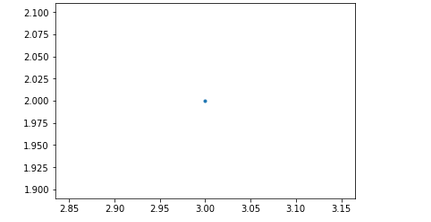
from matplotlib.backends.backend_agg import FigureCanvasAgg from matplotlib.figure import Figure fig = Figure() canvas = FigureCanvasAgg(fig) ax = fig.add_subplot(111) ax.plot(3, 2, '.') canvas.print_png('test.png') ##notebook 中用html显示图片
%%html <img src = 'test.png'/>
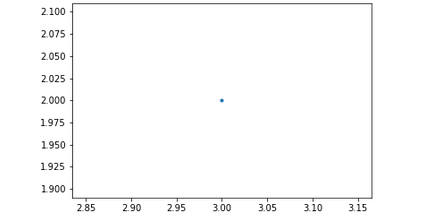
2. 用plt.gca()用法
plt.figure() plt.plot(3, 2, 'o') ax = plt.gca() ax.axis([0,6,0,10])
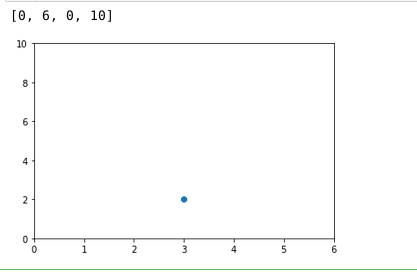
plt.figure() plt.plot(1.5,1.5,'o') plt.plot(2,2,'o') plt.plot(2.5,2.5,'o')
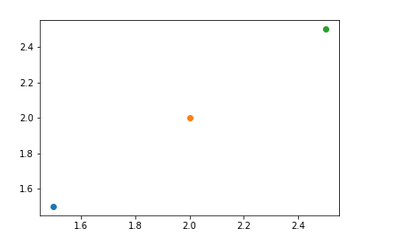
3. Scatterplot()
import numpy as np x = np.array([1,2,3,4,5,6,7,8]) y = x plt.figure() plt.scatter(x,y)
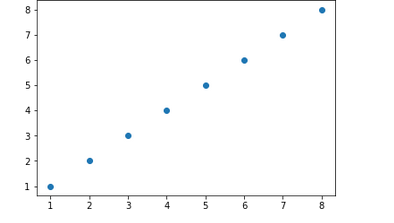
import numpy as np x = np.array([1,2,3,4,5,6,7,8]) y = x colors = ['green']*(len(x)-1) colors.append('red') plt.figure() plt.scatter(x,y,s=100, c=colors) #s为scatter 点的size

zip()
zip_generator = zip([1,2,3,4,5],[6,7,8,9,10]) list(zip_generator) """ output: [(1, 6), (2, 7), (3, 8), (4, 9), (5, 10)] """
zip_generator = zip([1,2,3,4,5],[6,7,8,9,10]) #unpack this result into two variables directly ,x ans y x,y = zip(*zip_generator) print(x) print(y) #output: # (1, 2, 3, 4, 5) # (6, 7, 8, 9, 10) #
散点图画法
plt.figure() plt.scatter(x[:2], y[:2], s=100, c='red', label='Tall students') plt.scatter(x[2:], y[2:], s=100, c='blue', label ='Short student') plt.xlabel('The number of times the child kicked a ball') plt.ylabel('The grade of the student') plt.title('Relationship between ball kicking and grades') plt.legend() plt.legend(loc=4, frameon=False, title='Legend') #右下角

4. Linear plot
import numpy as np linear_data = np.array([1,2,3,4,5,6,7,8]) quadratic_data = linear_data**2 plt.figure() plt.plot(linear_data, '-o', quadratic_data, '-o') plt.plot([22,44,55], '--r') plt.xlabel('Some data') plt.ylabel('Some other data') plt.title('A title') plt.legend(['Baseline', 'Competition', 'Us']) #fill plt.gca().fill_between(range(len(linear_data)), linear_data, quadratic_data, facecolor='blue', alpha = 0.25)

plt.figure() observation_dates = np.arange('2017-01-01', '2017-01-09', dtype='datetime64[D]') plt.plot(observation_dates, linear_data, '-o', observation_dates, quadratic_data,'-o')
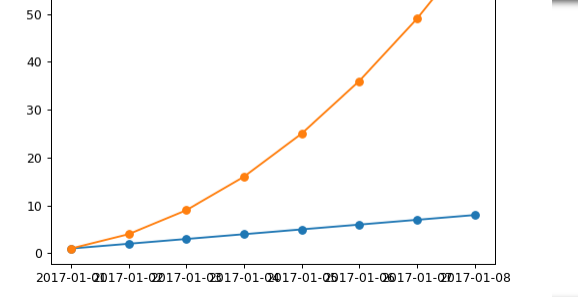
plt.figure() observation_dates = np.arange('2017-01-01','2017-01-09', dtype='datetime64[D]') observation_dates = list(map(pd.to_datetime, observation_dates)) plt.plot(observation_dates, linear_data, '-o', observation_dates, quadratic_data, '-o') x = plt.gca().xaxis for item in x.get_ticklabels(): item.set_rotation(45) #旋转一定的角度 plt.subplots_adjust(bottom=0.25) #调整与底部的距离 ax = plt.gca() ax.set_xlabel('Date') ax.set_ylabel('Units') ax.set_title('Quadratic vs. Linear performance') ax.set_title('Quadratic ($x^2$) vs. Linear ($x$) performance' ) #Latex
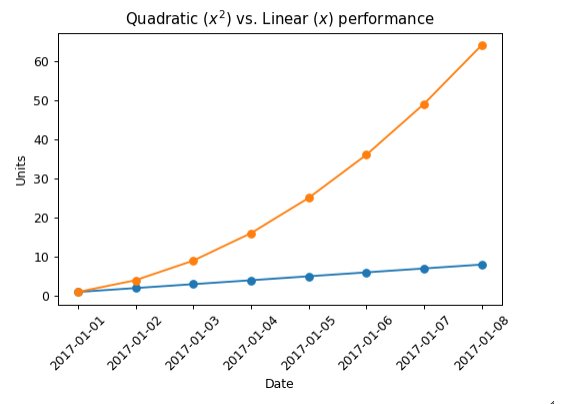
5 . Bar chart
plt.figure() xvals = range(len(linear_data)) plt.bar(xvals, linear_data, width=0.3) new_xvals = [] for item in xvals: new_xvals.append(item+0.3) plt.bar(new_xvals, quadratic_data, width=0.3, color='red') from random import randint linear_err = [randint(0,15) for x in range(len(linear_data))] plt.bar(xvals, linear_data, width=0.3, yerr = linear_err)

plt.figure() xvals = range(len(linear_data)) plt.bar(xvals, linear_data, width=0.3, color='b') plt.bar(xvals, quadratic_data, width=0.3, bottom = linear_data,color='r')

plt.figure() xvals = range(len(linear_data)) plt.barh(xvals, linear_data, height=0.3, color='b') plt.barh(xvals, quadratic_data, height=0.3, left=linear_data, color='r') #垂直变水平
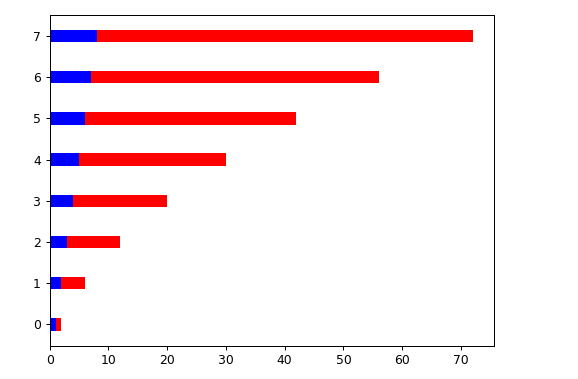
The Safest Way to Get what you Want is to Try and Deserve What you Want.

